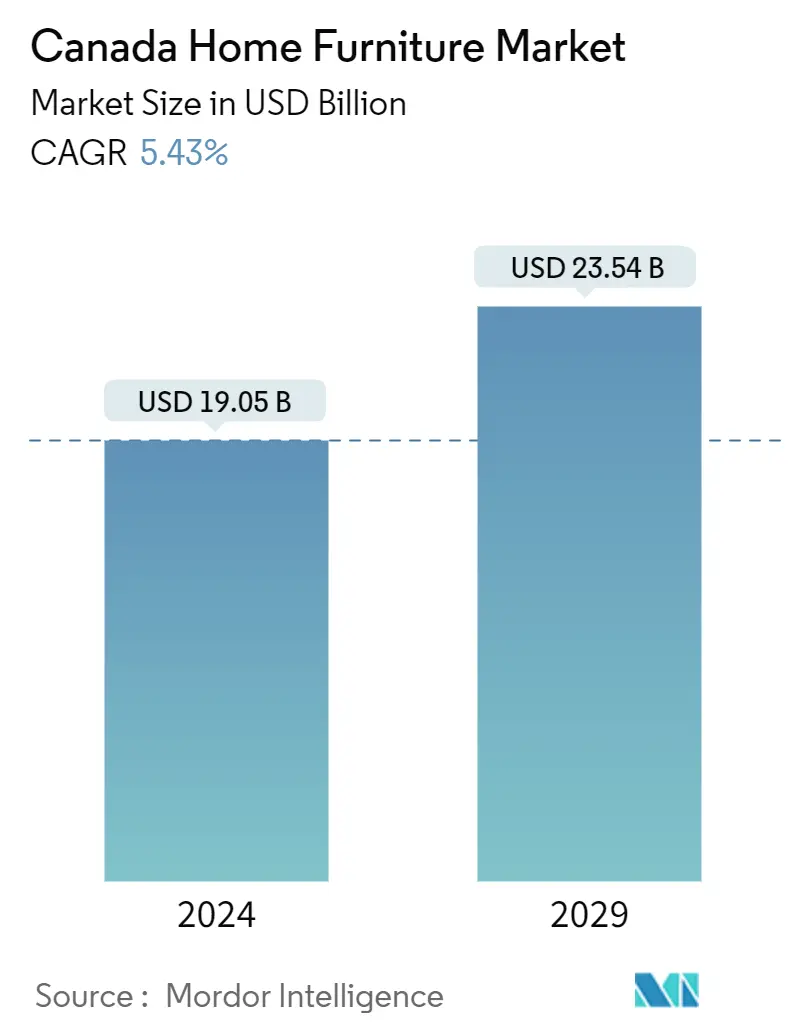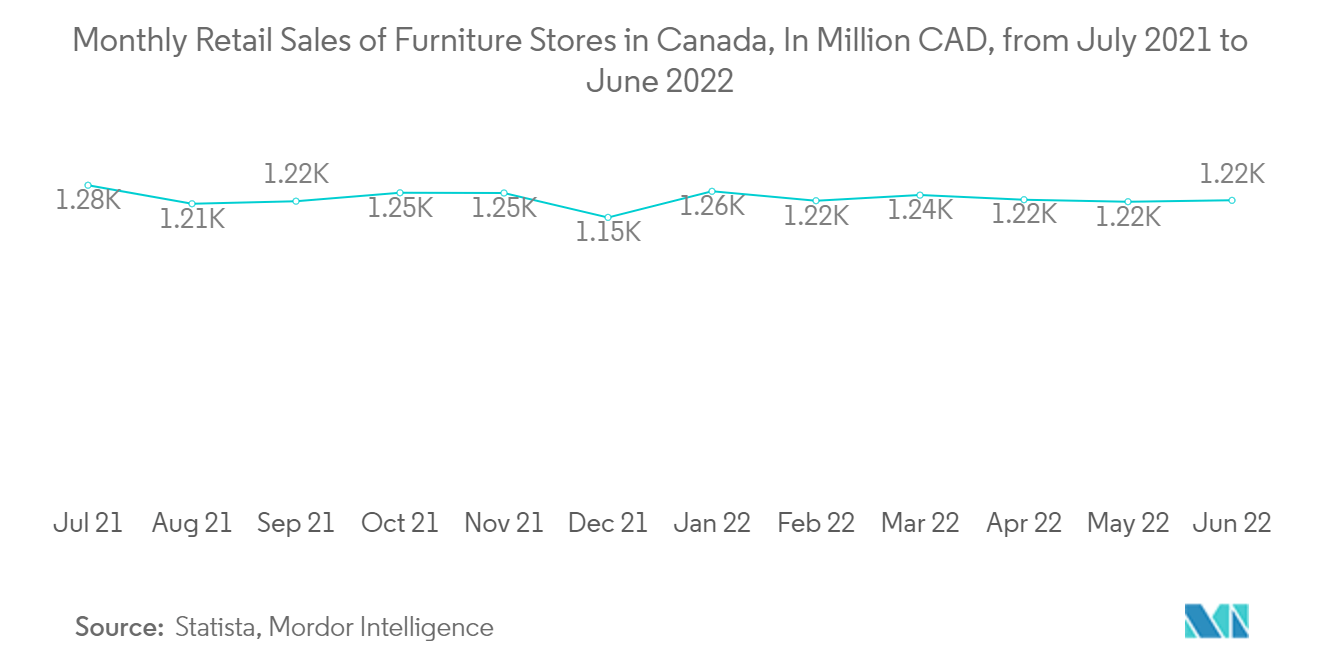Canada Furniture Market Size

| Study Period | 2020-2029 |
| Base Year For Estimation | 2023 |
| Market Size (2024) | USD 19.05 Billion |
| Market Size (2029) | USD 23.54 Billion |
| CAGR (2024 - 2029) | 5.43 % |
| Market Concentration | Medium |
Major Players
*Disclaimer: Major Players sorted in no particular order |
Canada Furniture Market Analysis
The Canada Home Furniture Market size is estimated at USD 19.05 billion in 2024, and is expected to reach USD 23.54 billion by 2029, growing at a CAGR of 5.43% during the forecast period (2024-2029).
Canada is the fifth largest exporter of furniture in the world. The furniture industry in Canada is made up of wood cabinet and countertop manufacturers, office furniture and institutional furniture manufacturers, and blinds & shades manufacturers. It also includes home furniture manufacturers along with mattress manufacturers.
Canada is one of the top ten furniture manufacturers in the world. It is due to the channelized nature of production, distribution, and selling and the growing demand for home furnishings (driven by consumer spending capacity). The growth of the infrastructure sectors, such as real estate and tourism, also contributes to the growth of the commercial furniture market in Canada. In addition, the country is known for producing carved and specialized wood furniture. These are the main factors driving the growth of the home furniture industry in Canada.
The increasing per capita income of the middle class is driving the growth of the home furnishings sector in Canada. The increasing demand for business furniture in the country is partly due to the growth of infrastructure industries such as real estate, tourism, etc. In addition, the country is well-known for producing specialty and carved wooden furniture. Furniture brands want to increase their presence in major cities by collaborating with their local distributors and setting up their stores. Since internet players carved a niche in this industry, its growth is wider than traditional high-street retailers. These are the main reasons driving the growth of Canada’s home furnishings sector.
The impact of the COVID-19 crisis on consumer behavior and manufacturing trends heightened the importance of digitalization and automation for the furniture industry. Online-savvy consumers seeking personalized shopping experiences and competitive prices are pushing furniture manufacturers to innovate their existing workflows.
Canada Furniture Market Trends
The Living and Dining Rooms Furniture holds the Largest Share.
Due to improved housing activity and rising expenditure on home furniture products, Canada is witnessing strong growth in the sales of furniture products. The market is consumer-oriented, with household sales for bedroom, living room, and dining room furniture accounting for the majority share, followed by expenditure on other furniture categories.
Due to the increasing demand for high-end furniture, Canadians value durability and long-lasting pieces, particularly in the design centers of Toronto and Montreal. Wooden products are majorly preferred for country living and dining room furniture. In addition, the demand for ready-to-assemble furniture is also rising in middle-income households. The outbreak of the COVID-19 pandemic surged the trend of do-it-yourself furniture as more people were stuck at home during the lockdowns.

Consumer Tastes and Trends are Changing and Spending on Home Furniture is Increasing
One of the main reasons for this market is the increasing demand for bespoke and one-of-a-kind furniture among consumers. As people become more conscious of their style and how they express themselves, bespoke furniture offers them the chance to design and create furniture that reflects their style and preferences.
Another factor that contributed to the growth of custom furniture is the increasing trend of buying furniture online. Online furniture shopping platforms allow customers to easily personalize their furniture pieces by choosing from a wide range of fabrics, colors, and finishes.
The growing demand for eco-friendly, sustainable furniture also influences the custom furniture market. People are looking for furniture made from eco-friendly materials and produced sustainably. Custom furniture makers are responding to this need by providing eco-friendly choices and sustainable production methods.

Canada Furniture Industry Overview
The Canadian home furniture market is moderately fragmented and consists mainly of small or medium-sized family-owned and operated firms. To meet the global competition, the players are building larger production capacity and focusing on achieving economies of scale. The major market players are IKEA Canada, Palliser, Durham Furniture, Bermex, and Bensen.
Canada Furniture Market Leaders
-
IKEA Canada
-
Palliser
-
Durham Furniture
-
Bermex
-
Bensen
*Disclaimer: Major Players sorted in no particular order

Canada Furniture Market News
- June 2023: IKEA Canada invested USD 400 million into projects that expand fulfillment capabilities in the Greater Vancouver and Toronto Areas. IKEA Canada’s investment will help the brand continue to meet the evolving ways that customers shop, while supporting their commitment to help Canadians enjoy a better life at home.
- April 2022: Living Spaces partners with HGTV Stars, Entrepreneurs Drew, and Jonathan Scott to Launch the Exclusive Furniture Collection of a new exclusive furniture collection with HGTV home design-renovation.
Canada Home Furniture Market Report - Table of Contents
1. INTRODUCTION
1.1 Study Assumptions & Market Definition
1.2 Scope of the Study
2. RESEARCH METHODOLOGY
3. EXECUTIVE SUMMARY
4. MARKET DYNAMICS
4.1 Market Drivers
4.1.1 Wooden Furniture Products are Preferred in Canadian Households
4.1.2 Rise in the Demand of Furniture Residential Segment
4.2 Market Restraints
4.2.1 Changes in Consumer Preferences and Behavior
4.3 Market Opportunities
4.3.1 Offering Customization can Drive the Market
4.3.2 Demand for Furniture in Commercial Segment
4.4 Porter's Five Forces Analysis
4.4.1 Bargaining Power of Suppliers
4.4.2 Bargaining Power of Buyers/Consumers
4.4.3 Threat of New Entrants
4.4.4 Threat of Substitute Products
4.4.5 Intensity of Competitive Rivalry
4.5 Impact of COVID-19 on the market
4.6 Insights on Technological Innovations in the Market
5. MARKET SEGMENTATION
5.1 By Product
5.1.1 Living-Room and Dining-Room Furniture
5.1.2 Bedroom Furniture
5.1.3 Kitchen Furniture
5.1.4 Lamps and Lighting Furniture
5.1.5 Plastic and Other Furniture
5.2 By Distribution Channel
5.2.1 Home Centres
5.2.2 Specialty Stores
5.2.3 Flagship Stores
5.2.4 Online
5.2.5 Others
6. COMPETITIVE LANDSCAPE
6.1 Market Concentration Overview
6.2 Company Profiles
6.2.1 IKEA Canada
6.2.2 Pallister
6.2.3 Durham Furniture
6.2.4 Bermex
6.2.5 Kitchencraft
6.2.6 Bensen
6.2.7 Future Fine Furniture
6.2.8 BirchWood Furniture
6.2.9 HaberSham
6.2.10 Kavuus*
- *List Not Exhaustive
7. FUTURE MARKET TRENDS
8. DISCLAIMER
Canada Furniture Industry Segmentation
Furniture can be defined as furniture products used for residential and commercial applications in various rooms, including living rooms, dining rooms, bedrooms, and others. The Canadian furniture market is segmented by product and distribution channel. By product, the market is segmented into living-room and dining-room furniture, bedroom furniture, kitchen furniture, lamps and lighting furniture, plastic, and other furniture. By distribution channel, the market is segmented into home centers, flagship stores, specialty stores, online, and other distribution channels. The report offers market size and forecasts for the Canadian furniture market in value (USD) for all the above segments.
| By Product | |
| Living-Room and Dining-Room Furniture | |
| Bedroom Furniture | |
| Kitchen Furniture | |
| Lamps and Lighting Furniture | |
| Plastic and Other Furniture |
| By Distribution Channel | |
| Home Centres | |
| Specialty Stores | |
| Flagship Stores | |
| Online | |
| Others |
Canada Home Furniture Market Research Faqs
How big is the Canada Home Furniture Market?
The Canada Home Furniture Market size is expected to reach USD 19.05 billion in 2024 and grow at a CAGR of 5.43% to reach USD 23.54 billion by 2029.
What is the current Canada Home Furniture Market size?
In 2024, the Canada Home Furniture Market size is expected to reach USD 19.05 billion.
Who are the key players in Canada Home Furniture Market?
IKEA Canada, Palliser, Durham Furniture, Bermex and Bensen are the major companies operating in the Canada Home Furniture Market.
What years does this Canada Home Furniture Market cover, and what was the market size in 2023?
In 2023, the Canada Home Furniture Market size was estimated at USD 18.02 billion. The report covers the Canada Home Furniture Market historical market size for years: 2020, 2021, 2022 and 2023. The report also forecasts the Canada Home Furniture Market size for years: 2024, 2025, 2026, 2027, 2028 and 2029.
What are the major Growth Opportunities in the Canada Home Furniture Market?
The major Growth Opportunities in the Canada Home Furniture Market are a) Expanding online retail channels b) Offering furniture customization options c) Integrating smart features into furniture
Canada Home Furniture Industry Report
The Canadian home furniture market is poised for steady growth, driven by increasing disposable income, urbanization, and evolving consumer preferences for stylish, comfortable living influenced by changing lifestyles and housing developments. Highlighted in industry reports, the furniture market in Canada experiences growing demand in segments such as living room, bedroom, dining room, and home office furniture, which emphasize multi-functionality, style, and durability.
Market dynamics are characterized by competitive pricing and innovative designs. Trends such as sustainable, eco-friendly furniture and smart furniture innovations are reshaping the landscape. Expanding online retail and customization opportunities cater to a consumer base seeking convenience and personalization. Despite intense competition, market players have significant opportunities to leverage advanced digital channels, eco-conscious manufacturing, and innovative retail strategies to sustain growth and thrive in the industry.
The market size and market value are crucial aspects to consider, and a detailed industry analysis provides insights into market segmentation and market overview. The industry outlook and market outlook suggest promising market growth, supported by market data and market forecast. Industry information and industry statistics indicate the current state and future potential, while industry research and market review offer comprehensive views on industry trends and market predictions.
Industry reports and research companies provide valuable industry information. The growth rate of the market is indicative of its potential, and the industry sales reflect the market leaders' performance. A report example or report pdf from reliable sources can provide further clarity on the market forecast. The market segmentation reveals diverse consumer preferences, and the market overview helps in understanding the broader market trends.
For a detailed perspective, access a free PDF sample report from Mordor Intelligence™, which includes a market forecast, historical overview, and analysis of the Canada furniture market.



